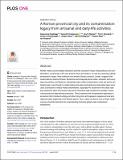Files in this item
A Roman provincial city and its contamination legacy from artisanal and daily-life activities
Item metadata
| dc.contributor.author | Holdridge, Genevieve | |
| dc.contributor.author | Kristiansen, Søren M. | |
| dc.contributor.author | Barfod, Gry H. | |
| dc.contributor.author | Kinnaird, Tim C. | |
| dc.contributor.author | Lichtenberger, Achim | |
| dc.contributor.author | Olsen, Jesper | |
| dc.contributor.author | Philippsen, Bente | |
| dc.contributor.author | Raja, Rubina | |
| dc.contributor.author | Simpson, Ian | |
| dc.date.accessioned | 2021-06-21T09:30:08Z | |
| dc.date.available | 2021-06-21T09:30:08Z | |
| dc.date.issued | 2021-06-09 | |
| dc.identifier | 274570224 | |
| dc.identifier | 032c00b8-609d-4f89-ae71-453da2573886 | |
| dc.identifier | 000664642200021 | |
| dc.identifier | 85107915118 | |
| dc.identifier.citation | Holdridge , G , Kristiansen , S M , Barfod , G H , Kinnaird , T C , Lichtenberger , A , Olsen , J , Philippsen , B , Raja , R & Simpson , I 2021 , ' A Roman provincial city and its contamination legacy from artisanal and daily-life activities ' , PLoS ONE , vol. 16 , no. 6 , e0251923 . https://doi.org/10.1371/journal.pone.0251923 | en |
| dc.identifier.issn | 1932-6203 | |
| dc.identifier.other | Jisc: 611c39a4e16c40ec981963f531d5ad42 | |
| dc.identifier.other | publisher-id: pone-d-21-01035 | |
| dc.identifier.uri | https://hdl.handle.net/10023/23400 | |
| dc.description | Funding: This project was supported by the Carlsberg Foundation (R.R., www.carlsbergfondet.dk, Grant CF14-0467), Danish National Research Foundation (R.R., www.dg.dk, Grant 119), the Deutsche Forchungsgemeinschaft (A.L., https://www.dfg.de/, grant nos LI978/4-1 and LI978/4-2), the Deutscher Palästinaverein (A.L., https://www.palaestina-verein.de/), the Danish EliteForsk Award (R.R., https://ufm.dk/forskning-og-innovation/forskningsformidling/eliteforsk, grant 4094-00077B), and H. P. Hjerl Hansens Mindefondet for Dansk Palæstinaforskning (RR). | en |
| dc.description.abstract | Roman metal use and related extraction activities resulted in heavy metal pollution and contamination, in particular of Pb near ancient mines and harbors, as well as producing a global atmospheric impact. New evidence from ancient Gerasa (Jerash), Jordan, suggests that small-scale but intense Roman, Byzantine and Umayyad period urban, artisanal, and everyday site activities contributed to substantial heavy metal contamination of the city and its hinterland wadi, even though no metal mining took place and hardly any lead water pipes were used. Distribution of heavy metal contaminants, especially Pb, observed in the urban soils and sediments within this ancient city and its hinterland wadi resulted from aeolian, fluvial, cultural and post-depositional processes. These represent the contamination pathways of an ancient city-hinterland setting and reflect long-term anthropogenic legacies at local and regional scales beginning in the Roman period. Thus, urban use and re-use of heavy metal sources should be factored into understanding historical global-scale contaminant distributions. | |
| dc.format.extent | 10 | |
| dc.format.extent | 2072001 | |
| dc.language.iso | eng | |
| dc.relation.ispartof | PLoS ONE | en |
| dc.subject | GE Environmental Sciences | en |
| dc.subject | DAS | en |
| dc.subject | SDG 11 - Sustainable Cities and Communities | en |
| dc.subject.lcc | GE | en |
| dc.title | A Roman provincial city and its contamination legacy from artisanal and daily-life activities | en |
| dc.type | Journal article | en |
| dc.contributor.institution | University of St Andrews. School of Earth & Environmental Sciences | en |
| dc.identifier.doi | https://doi.org/10.1371/journal.pone.0251923 | |
| dc.description.status | Peer reviewed | en |
This item appears in the following Collection(s)
Items in the St Andrews Research Repository are protected by copyright, with all rights reserved, unless otherwise indicated.

